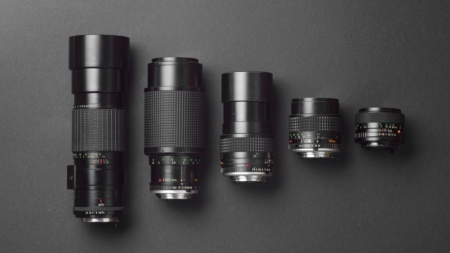How To Buy Cheap Vintage Lenses for Your Modern Mirrorless Camera
When you buy a modern mirrorless camera like the Sony A7S iii, the first thing you’re going to notice is that the premium lenses for it like the 24-70 f2.8 GMaster cost about $2,400. Even less expensive lenses like the Tamron 2.8 24-70mm are going to run you $800.
And god forbid you want more lenses for different looks. Say you also want a wide-angle lens (less than 24mm), a zoom lens (greater than 70mm), a fish-eye lens, and a faster f1.4 lens. We’re talking about spending several thousand dollars on lenses here.
However, there is a cheaper alternative if you want to get creative. Buying vintage lenses with an adapter will cost you considerably less money while allowing you to film a ton of different looks. Some of which you might like better than the modern equivalents.
The Downside of Buying Vintage Lenses for Modern Mirrorless Cameras
Let’s start with the downside of old lenses and why you may want to stick with modern lenses. Two significant problems come up when I think about buying vintage lenses.
1) The Autofocus on Your Camera Won’t Work
The big problem with vintage lenses is that they weren’t made to work with your camera’s auto-focus system. Most modern lenses have internal mechanisms that you can barely hear moving around that focus the camera. Your standard M42 to Sony e-mount adapter has no such mechanism.

Some adapters out there can move your lens around and re-enable autofocus, even on vintage glass. They may come with limitations such as needing to use phase-detect autofocus or just not doing a great job of pulling focus.
You’re probably going to have to enjoy manually focusing to use vintage lenses. If you’re a run and gun vlogger where autofocus is critical, this won’t work great for you.
2) Vintage Lenses Are Oftentimes Radioactive
Many lenses built in the 1940s through the 1970s used thorium oxide in their glass and are measurably radioactive. You can usually spot them easily enough as the glass will turn yellow. Here’s a good website that details lenses found to be radioactive.
For and in-depth analysis of the radiation levels, check out the video below. It’s a real treat.
In the video, his Geiger counter comes with a handy guide for radiation levels similar to the table below. It’s a handy guide for understanding exactly how much radiation these lenses are putting out.
| CPM | micro-Sievert/hour (uSv/hr) | mR/h | Action |
|---|---|---|---|
| 5 – 50 | 0.03 – 0.33 | 0.003 – 0.033 | Normal background, no action needed |
| 51 – 99 | 0.33 – 0.65 | 0.033 – 0.065 | Medium Level, Check Reading Regularly |
| >100 | >0.65 | >0.065 | High Level, Closely watch reading, find out why |
| >1000 | >6.50 | >0.650 | Very High, Leave the area ASAP. Find out why |
| >2000 | >13 | >1.3 | Extremely High, Evacuate immediately, report to government. |
In his test, the vintage lens he used put out 13.77 micro-Sievert/hour (uSv/hr). Which, as you may notice, is in the “Extremely high, Evacuate immediately and report to government.” territory. This sounds scary, but keep two points in mind.
- Even holding it against your skin at 13.77 micro-Sievert/hour, it’d take 151 straight days of that before you hit the 50,000 micro-Sievert limit that is considered occupationally dangerous.
- The radiation dramatically decreases with a small amount of distance. When placed one foot away from the Geiger counter it was showing negligible background levels of radiation again.
The gist is you really shouldn’t hold this lens up to your brain, eyes, or vital organs for any length of time. Or collect dozens of them and place them all on top of you. And I also wouldn’t leave it mounted to your camera overnight or store the lenses within a couple feet of anything you don’t want getting a dose of radiation.
Past that, I think they’re fine. But, it’s definitely something to be aware of and to make your own decision on. Once you’ve made your decision, let’s check out some cool options for vintage lenses!
Wide Angle / Fish-eye Lenses
Once you want to go significantly wider than 30mm or use a fish-eye lens, you’re likely better off going with modern lenses.
We’ve gotten significantly better at making these types of lenses over the past 60+ years, there aren’t many great options floating around for cheap in the vintage space.
30mm Lenses
At 30mm, this is where vintage lenses start to get a little bit interesting. There are many options out there; here are a few notable ones to search eBay for. But, this is far from a definitive list.
- Meyer-Optic Gorlitz Orestegon 2.8 / 29mm Exakta Mount Zebra Lens
- Meyer Optik Gorlitz Lydith 3.5/30mm f/3.5 30mm
- PENTAX Super Multi Coated TAKUMAR 28mm f3.5
Macro Lenses
There are vintage lenses that would be great for close up photography. This is where buying vintage glass is pretty cool. To even experiment with this on the current Sony lineup, you’re probably looking at buying a dedicated lens that costs you at least a few hundred dollars. You can try to make it work with vintage glass for maybe $100 or less if you wait for a deal. Here are a couple options to search eBay for.
Nifty Fifty’s
This is where vintage lenses really just have nearly infinite options. It really seems like everything was a nearly 50-ish mm focal length back in the day. Here are a handful of options that exist out there and that you can search eBay for.
Zoom / Telephoto Vintage Lenses
This is another area where vintage lenses are kind-of cool. Most lenses I buy as a vlogger are in the 18mm-70mm range. As such, I don’t own anything that’s 200mm. If I wanted to buy a modern lens that can do this, we’re probably talking about several hundred dollars at a minimum.
Conclusion
If you can get over the radioactivity and shooting manual focus thing, vintage lenses can be a lot of fun to play around with at an affordable price compared to their modern equivalents. They’re also an affordable gift idea provided the recipient is cool with the radioactivity.


